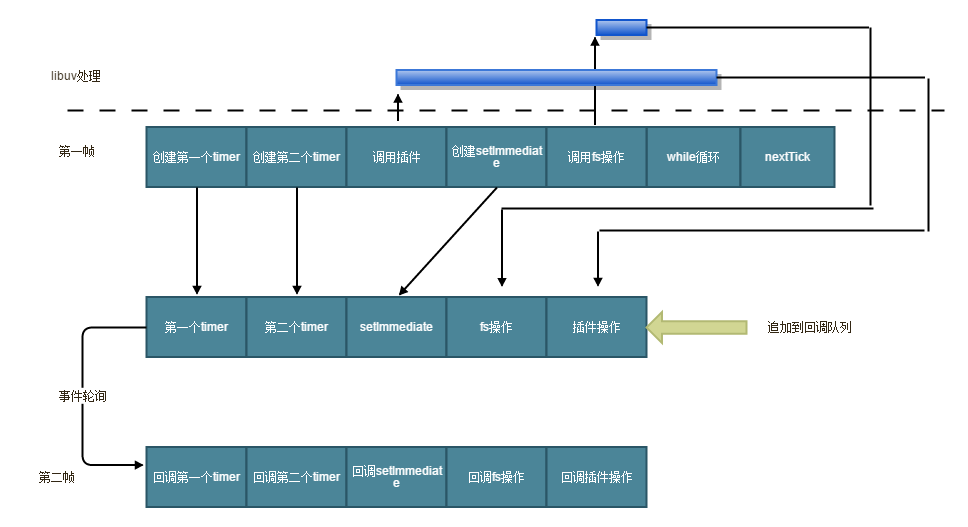js异步之惑
1.异步是啥
与异步对应的就是同步,对于同步我们很好理解,就是代码顺序执行。但是一到异步代码,很多人多少有些理不清。异步,从功能上讲,就是在背后偷偷的执行,不堵塞当前运行的代码;从实现上讲,能够这么做的,就只能靠在当前运行代码中另一起线程或者进程了。举一个使用线程来实现异步的例子:
public class MyAsync extends Thread {
private volatile boolean done = false;
public void run() {
while (!done) {//子线程中的循环
System.out.println("thread out x");
try {
Thread.sleep(500);
} catch (InterruptedException e) {
e.printStackTrace();
// Thread.currentThread().interrupt();
}
}
}
public synchronized void setDone() {
done = true;
}
public static void main(String argv[]) {
MyAsync t = new MyAsync();
t.start();//起子线程
long last = System.currentTimeMillis();
int count = 0;
while(true) {//主线程中循环
long now = System.currentTimeMillis();
if (now - last > 1000 * 1) {
last = now;
count ++;
System.out.println("the " + count + "th count.");
}
if (count > 2) {
break;
}
}
t.setDone();
}
}代码1.1 线程示例
对于代码1.1的运行结果,有可能是这个样子的:
thread out x
thread out x
thread out x
the 1th count.
thread out x
thread out x
the 2th count.
thread out x
thread out x
the 3th count.
代码27-38行起是主线程循环,7-15行是子线程循环,你多运行几次,就可以看出两个循环的输出是很随机的,但是不管运行多少次两个循环的输出都是交叉在一起的。这样我们就可以推断出,运行主线程的代码的时候,子线程的代码也在背后偷偷的运行,说白了两者是并行运行的。
2.js中的异步
就是因为异步这个特性,js如今被大家推崇,下面用一个小例子来演示一下js中异步的使用:
function synchronizedCode() {
var last = new Date().getTime();
var count = 0;
while (true) {
var now = new Date().getTime();
if (now - last > 1000 * 2) {
last = now;
count++;
console.log('the %dth count.',count);
}
if (count > 9) {
console.log('exist while.');
break;
}
}
}
(function() {
setTimeout(function() {console.log('setTimeout 0 occured first.');},0);
setTimeout(function() {console.log('setTimeout 0 occured second.');},0);
synchronizedCode();
})();代码2.1 setTimeout的例子
我们运行代码2.1,然后不管运行多少次,输出都是这个样子的:
the 1th count.
the 2th count.
the 3th count.
the 4th count.
the 5th count.
exist while.
setTimeout 0 occured first.
setTimeout 0 occured second.
输出2.1
跟java中的异步和同步代码会交叉输出相比,js中的异步其实是排好队输出的。由于js是单线程执行代码的,所以没有那种交叉输出的效果。那么还有一个问题,while循环明明运行了5秒钟,为何在这期间那两个setTimeout一直没有运行呢?这就和js代码的异步机制有关了。js代码中有帧的概念,对于同步代码是在当前帧运行的,异步代码是在下一帧运行的。对于代码2.1我们给代码运行画一幅图的话,应该是这样的:
图2.1 js帧结构
那么为什么是第一个setTimeout先触发,第二个后触发呢,难道仅仅由于先后顺序?我们把第一个setTimeout改为setTimeout(function() {console.log('setTimeout 0 occured first.');},100);,那么输出的时候就会是先输出setTimeout 0 occured second.,在输出setTimeout 0 occured first.。也就是说在第二帧setTimeout的回调的执行顺序不仅与代码顺序有关还和延迟时间有关。
在node.js中还有一个特殊的API,就是process.nextTick,虽然已经不推荐使用了,但是已经可以在很多代码中看到它的身影。例如如下代码:
(function() {
setTimeout(function() {console.log('setTimeout 0 occured first.');},0);
setTimeout(function() {console.log('setTimeout 0 occured second.');},0);
process.nextTick(function() {console.log('nextTick occured.');});
synchronizedCode();
})();代码2.2
运行后输出:
the 1th count.
the 2th count.
the 3th count.
the 4th count.
the 5th count.
exist while.
nextTick occured.
setTimeout 0 occured first.
setTimeout 0 occured second.
输出2.2
之所以nextTick排在所有异步的最前面,是由于nextTick是在第一帧运行的,而其他的都是在第二帧运行的。也就是说代码运行情况是这个样子的:
图2.2 js帧结构
接下来再举几个异步API的例子,这次我们添加setImmediate和mkdir两个函数:
var synchronizedCode = require('./sync');
(function() {
setTimeout(function() {console.log('setTimeout 0 occured first.');},0);
setTimeout(function() {console.log('setTimeout 0 occured second.');},0);
process.nextTick(function() {console.log('nextTick occured.');});
setImmediate(function() {console.log('setImmediate occured.')});
var fs = require('fs');
var crypto = require('crypto');
var rand = crypto.pseudoRandomBytes(8).toString('hex');
fs.mkdir('d:\\temp\\xx'+'\\'+rand,function(err) {
if (err) {
console.log(err,'错误',err.code);
} else {
console.log('create directory success.');
}
});
synchronizedCode();
})(); 代码2.3
那么他的输出就应该是这样的:
the 1th count.
the 2th count.
the 3th count.
the 4th count.
the 5th count.
exist while.
nextTick occured.
setTimeout 0 occured first.
setTimeout 0 occured second.
setImmediate occured.
create directory success.
输出2.3
等等,问题来了,这里最后一句才打印create directory success,那么是不是程序是在最后一步才创建的文件夹呢,如果真是这样,就有点低效了,起码这个创建文件的工作被那个while循环给延迟了得有5秒钟。不过幸好,这个想法是错误的!node.js中使用libuv来IO或者CPU计算量大的操作,而在libuv中处理这些耗时的操作都是用线程来解决,以避免堵塞住js线程(这一点和android的程序设计思路类似,android开发中使用子线程来处理耗时逻辑,避免对主线程造成卡顿)。这里我们来演示一个libuv的异步处理,在异步处理中模拟一个耗时操作:
#include <node.h>
#include <string>
#include <v8.h>
#include <nan.h>
#ifdef WINDOWS_SPECIFIC_DEFINE
#include <windows.h>
typedef DWORD ThreadId;
#else
#include <unistd.h>
#include <pthread.h>
typedef unsigned int ThreadId;
#endif
using namespace v8;
NAN_METHOD(async_hello);
static ThreadId __getThreadId() {
ThreadId nThreadID;
#ifdef WINDOWS_SPECIFIC_DEFINE
nThreadID = GetCurrentProcessId();
nThreadID = (nThreadID << 16) + GetCurrentThreadId();
#else
nThreadID = getpid();
nThreadID = (nThreadID << 16) + pthread_self();
#endif
return nThreadID;
}
static void __tsleep(unsigned int millisecond) {
#ifdef WINDOWS_SPECIFIC_DEFINE
::Sleep(millisecond);
#else
usleep(millisecond*1000);
#endif
}
class ThreadWoker : public NanAsyncWorker {
private:
std::string str;
public:
ThreadWoker(NanCallback *callback,std::string str)
: NanAsyncWorker(callback), str(str) {}
~ThreadWoker() {}
//在该函数内模拟处理过程 ,如i/o阻塞或者cpu高消耗情形的处理。
// 注意不能使用v8 api,这个线程不是在js主线程内
void Execute() {
printf("\n%s Thread id : gettid() == %d\n",__FUNCTION__,__getThreadId());
for (int i=0;i<15;i++) {
__tsleep(1000);
printf("sleep 1 seconds in uv_work\n");
}
}
void HandleOKCallback () {
NanScope();
Local<Value> argv[] = {
NanNull(),
NanNew("the result:"+str)
};
callback->Call(2, argv);
};
};
NAN_METHOD(async_hello) {
printf("\n%s Thread id : gettid() == %d\n",__FUNCTION__,__getThreadId());
NanScope();
if(args.Length() < 2) {
NanThrowError("Wrong number of arguments");
NanReturnUndefined();
}
if (!args[0]->IsString() || !args[1]->IsFunction()) {
NanThrowError("Wrong number of arguments");
NanReturnUndefined();
}
// 强制转换成函数变量
NanCallback *callback = new NanCallback(args[1].As<Function>());
NanUtf8String param1(args[0]);
std::string str = std::string(*param1);
NanAsyncQueueWorker(new ThreadWoker(callback, str));
NanReturnUndefined();
}
void Init(Handle<Object> exports) {
exports->Set(NanNew<String>("async_hello"),
NanNew<FunctionTemplate>(async_hello)->GetFunction());
}
NODE_MODULE(binding, Init);代码2.4
编写的测试代码,将其运行,就可以看出函数Execute根本就不在js线程中执行,也就是说它是可以和js线程并行的;函数HandleOKCallback中能够触发js中的回调函数,将处理完的结果交给js。下面就编译上面代码(需要node-gyp支持,执行node-gpy rebuild进行编译),来验证上述结论:
(function() {
setTimeout(function() {synchronizedCode('timer1',3);},0);
setTimeout(function() {console.log('setTimeout 0 occured second.');},0);
process.nextTick(function() {console.log('nextTick occured.');});
var addon = require('./addon/build/Release/binding');
addon.async_hello("good",function(err, result) {
console.log('node addon result',result);
});
setImmediate(function() {console.log('setImmediate occured.')});
var fs = require('fs');
var crypto = require('crypto');
var rand = crypto.pseudoRandomBytes(8).toString('hex');
fs.mkdir('d:\\temp\\xx'+'\\'+rand,function(err) {
if (err) {
console.log(err,'错误',err.code);
} else {
console.log('create directory success.');
}
});
synchronizedCode();
})(); 代码2.5
我们在代码2.5中引入了代码2.4中的c++扩展,其输出内容如下
async_hello Thread id : gettid() == 284953360
call_work Thread id : gettid() == 284958096
sleep 1 seconds in uv_work
sleep 1 seconds in uv_work
the 1th count.
sleep 1 seconds in uv_work
sleep 1 seconds in uv_work
the 2th count.
sleep 1 seconds in uv_work
sleep 1 seconds in uv_work
the 3th count.
sleep 1 seconds in uv_work
sleep 1 seconds in uv_work
the 4th count.
sleep 1 seconds in uv_work
sleep 1 seconds in uv_work
the 5th count.
exist while.
nextTick occured.
sleep 1 seconds in uv_work
sleep 1 seconds in uv_work
the 1th count in [timer1].
sleep 1 seconds in uv_work
sleep 1 seconds in uv_work
the 2th count in [timer1].
sleep 1 seconds in uv_work
the 3th count in [timer1].
the 4th count in [timer1].
exist while in [timer1].
setTimeout 0 occured second.
setImmediate occured.
create directory success.
call_work_after Thread id : gettid() == 284953360
node addon result good--->hello world from c++
输出2.5
我们终于看到开篇提到的类似java代码的交叉输出的效果了。libuv在处理任务时根本就和js不在一个线程中,所以才出现了libuv线程和js线程交叉输出的效果。我们在梳理一下代码2.5的异步流程,那么可以用下面这个图来展示出来:
图2.3
在 node 中维护了一个回调的队列,那为什么调用插件的回调排在队列的最后面呢,是有于我们在代码2.4中故意将其代码设置成15秒之后才执行完成,这要远远长于其他的那些回调,所以它只能被追加到回调队列的最后一位。在第二帧中,node 中的事件轮询依次将这些回调队列中的任务取出来,进行触发调用。可以看出回调队列是个先进先出的结构。注意回调是按照队列中排队顺序执行的,同时它们执行的环境是 js 线程,要知道 js 线程可是个单线程,也就是说一旦某个回调中的同步代码耗时比较长,那么它后面的回调任务就得一直等着它运行完成,所以说一定不要在回调中写特别耗时的同步代码。
真实情况中,Node 的回调队列是有多个(例如 timer 回调在定时器回调队列中;文件操作和 C++ 插件操作的回调在 pending 回调队列中;setImmediate 在 check 回调队列中),本文为了方便初学者理解,将其描述为一个队列。
关于 Node 回调队列的内部调用顺序的详解可以参见官方网站上的说明,或者是笔者写的另一篇教程Node.js 体系结构。
3. 代码
本文用到代码发布在http://git.oschina.net/yunnysunny/async-tutorial-code